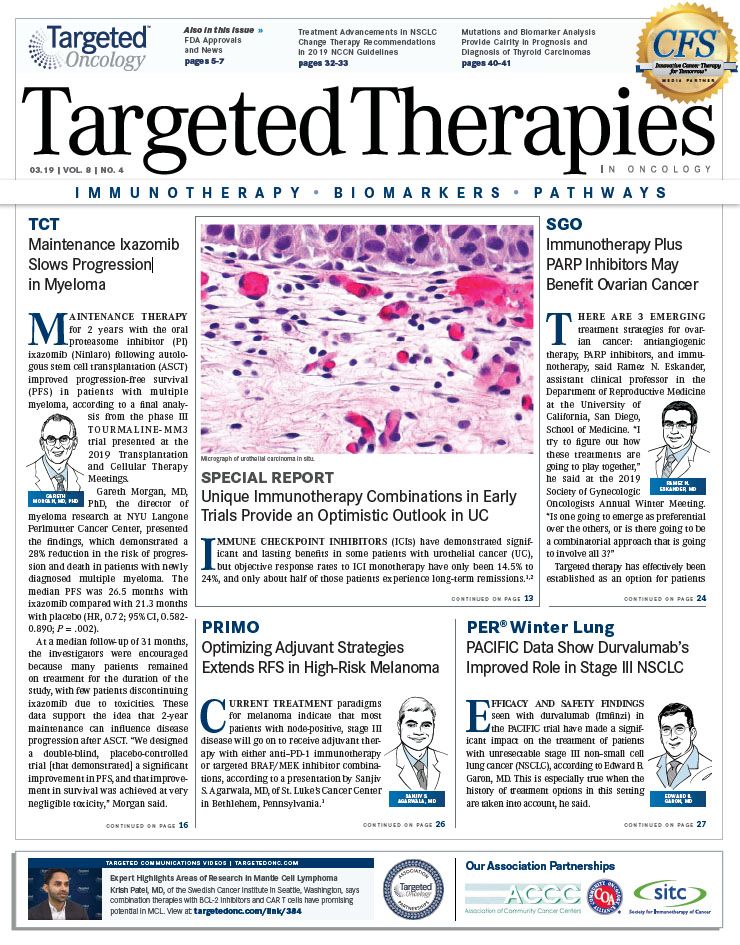Focusing On Optimal Settings for Selective Internal Radiation Therapy in CRC With Liver Mets
In an interview with <em>Targeted Therapies in Oncology</em>, Michael Cusnir, MD, explained that Y-90 is a type of beta emitter that is extremely focused, which allows for the treatment to be localized without affecting healthy portions of the liver or other structures surrounding the liver; it is delivered to selectively embolize the liver.

Selective internal radiation therapy (SIRT), or radioembolization, using yttrium-90 (Y-90) resin microspheres is currently indicated for use in the treatment of patients with unresectable metastatic colorectal cancer (CRC) who have hepatic metastases. The million-dollar question, though, for the use of SIRT with Y-90 microspheres, according to Michael Cusnir, MD, is the line of treatment. Recent data have helped clinicians further focus on the optimal settings for use of this treatment modality.
In an interview withTargeted Therapies in Oncology, Cusnir, the medical director of the Mount Sinai Comprehensive Cancer Center, explained that Y-90 is a type of beta emitter that is extremely focused, which allows for the treatment to be localized without affecting healthy portions of the liver or other structures surrounding the liver; it is delivered to selectively embolize the liver.
Cusnir said that most clinicians in the United States tend to consider SIRT for second-line therapy and beyond. However, recent findings have shown the potential for frontline use in select patients.
In a combined analysis of 2 randomized studies comparing chemotherapy with SIRT versus chemotherapy alone in the first-line setting, an unexpected survival benefit was seen from the addition of SIRT in patients with right-sided CRC.1The analysis showed that in both the SIRFLOX and FOXFIRE Global trials, patients with right-sided tumors especially benefited from SIRT treatment. The combined analysis showed that patients with right-sided primary CRC tumors treated with chemotherapy and SIRT had a median overall survival (OS) of 22.0 months compared with 17.1 months with chemotherapy alone (HR, 0.641;P= .008). In patients with left-sided primary tumors, the median OS was 24.6 months versus 26.6 months (HR, 1.120;P= .264), respectively.
Usually, right-sided primary CRC tumors have a worse prognosis, Cusnir explained, which is why this finding was so significant. “Most of the benefit seen with right-sided tumors is usually in the range of 3 or 4 months, and with the best chemotherapy options, the survival that we have seen is usually around 17 months for right-sided tumors. That is where we have been in the past. With this technology on the right-sided tumors in the frontline setting, the survival benefit was up to 22 months compared with the standard-of-care arm, which means that it almost broke the 2-year mark.”
This finding may help oncologists select more specifically which patients are most likely to benefit from SIRT with Y-90 microspheres in the frontline setting.
Currently, the National Comprehensive Cancer Network guidelines recommend radioembolization with a 2A category as a local treatment option for patients with unresectable liver metastases.2The current version of the guidelines acknowledge the potential benefit for earlier stages [of disease] in patients with right-sided primary tumors; however, they suggest that further study is needed for confirmation of the potential role of SIRT in such settings.
Cusnir suggested that this could perhaps be because the dose of the chemotherapy regimens used in the SIRFLOX study impacted the results of the study and agreed that further study is needed. Yet, the role for liver-directed SIRT in the second line or beyond seems to be proven. He suggested that many physicians may use SIRT as either a maintenance therapy or in the second line or beyond after a response. “Multiple studies for the second and third line have shown beneficial outcomes of patients of all the different types of disease entity, right or left, of CRC,” Cusnir noted.
For example, in a small matched-pair comparison study examining radioembolization with best supportive care or best supportive care alone in patients with chemotherapy-refractory CRC with liver metastases, the median survival with added radioembolization was more than double that with best supportive care alone (8.3 vs 3.5 months; HR, 0.3; 95% CI, 0.16-0.55;P<.001). There were few treatment-related adverse events, most of which were grade 1 or 2.3
“The research for subsequent lines appears to be much more impressive,” he said. “Knowing that we do not have that many lines of therapy for patients with CRC, anything that we add to the armamentarium is going to be beneficial as we go down the line with these types of treatment.”
“I do not believe, not to my knowledge, that sidedness has been analyzed in older studies [of SIRT in later lines] to see if the benefit was for both sidesright and left. The benefit that you could see on the third-line studies is so large compared with what we have available with chemotherapy options that I think the sidedness is not going to be brought into question for later lines,” Cusnir said.
SIRT is also undergoing investigation for the treatment of other gastrointestinal malignancies, Cusnir added, such as in primary hepatocellular carcinoma and neuroendocrine tumors and as a potential bridge to transplant. “[For] any tumor that has a preference for liver metastatic disease, without compromising other organs where you are treating the liver in a selective fashion, [SIRT] has an interest. We have seen a lot of different reports in a lot of different disease entities that appear to be interesting,” he concluded.
References:
- Gibbs P, Heinemann V, Sharma NK, et al; SIRFLOX and FOXFIRE Global Trial Investigators. Effect of primary tumor side on survival outcomes in untreated patients with metastatic colorectal cancer when selective internal radiation therapy is added to chemotherapy: combined analysis of two randomized controlled studies.Clin Colorectal Cancer.2018;17(4):e617-e629. doi: 10.1016/j.clcc.2018.06.001.
- NCCN Clinical Practice Guidelines in Oncology: Colon Cancer. Version 4.2018. National Comprehensive Cancer Network website. nccn.org/ professionals/physician_gls/pdf/colon.pdf. Published October 19, 2018. Accessed February 22, 2019.
- Seidensticker R, Denecke T, Kraus P, et al. Matched-pair comparison of radioembolization plus best supportive care versus best supportive care alone for chemotherapy refractory liver-dominant colorectal metastases.Cardiovasc Intervent Radiol.2012;35(5):1066-1073. doi: 10.1007/s00270- 011-0234-7.

Survivorship Care Promotes Evidence-Based Approaches for Quality of Life and Beyond
March 21st 2025Frank J. Penedo, PhD, explains the challenges of survivorship care for patients with cancer and how he implements programs to support patients’ emotional, physical, and practical needs.
Read More